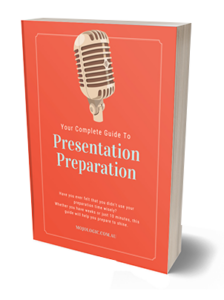Have you ever found yourself in the terrifying position of being called on to speak with almost no time to prepare?
“Fear paralyses you – fear of flying, fear of the future, fear of leaving a rubbish marriage, fear of public speaking, or whatever it is.”
-Annie Lennox
This is the scenario: You have just found out that due to unexpected circumstances you have only 10 minutes to prepare your presentation.
Few rarefied creatures are excited by this proposition.
Perhaps the rest of us can learn from the mindset (pathology?) of the experienced extemporaneous, working without a net – kind of verbal adrenalin junkies.
Obviously if your 10 minutes has already started now is NOT the time to read this blog post. But if you are scarred by having been put on the spot in the past or you think this may happen to you in the future, read on.
These are my observations followed by some suggestions for how you extract the essence of their success:
Know thyself
They have a pre-formulated understanding of their persona and a style they can draw on.
- What are three words that you would like your audience to use when describing your style?
Accept the limelight
They are comfortable holding the space in front of the group. They appear natural and at ease. They make eye-contact, ask questions, engage with their audience.
- Imagine you are having a conversation with a group of people you know and trust. If explaining a technical process, pretend you are speaking to your best friend.
Land the point
Successful speakers that deliver ‘off the cuff’ talks understand that it is ok to get lost in the middle, wander off on tangents and tell meandering stories. BUT they always do so in service of one, single-minded POINT.
- Have a point. Be clear on the one big thing you want to achieve. This could be framed in the form of what you want your audience to think, feel or do differently. Make that clear at the beginning and the end and let the messy middle unfold.
Extemporaneous Tips
Consider these four questions:
- What is the ONE THING you can leave your audience with? A new idea, a call to action, a lesson, etc.
- What impression do you want to create?
- What are the big themes you would like to cover? Jot them down
- What is the very first thing you will say?
Avoid a Panic
- Ask an open question as your introduction – either direct this question to the whole group, if it is reasonably small or ask specific people to contribute to the discussion. You have just bought yourself some time and clarified expectations.
- Take a minute to breathe. Or at least 30 seconds. Deep diaphragmatic breathing will slow your heart rate and help you to focus.
- Try a power pose. Amy Cuddy has some interesting research, found here. It certainly can’t hurt.
- Suggest a rough agenda – 3 points you plan to cover and check in with the audience – is there anything else you would like me to cover today?
- Slow your pace. If you rush, you will appear nervous. Begin slowly and calmly.
- Change your frame and think of this as a conversation rather than a presentation.
- Visualise yourself at your best — Imagine the audience smiling and nodding as you are speaking
Click here to get a free copy of your complete guide to Presentation Preparation.


